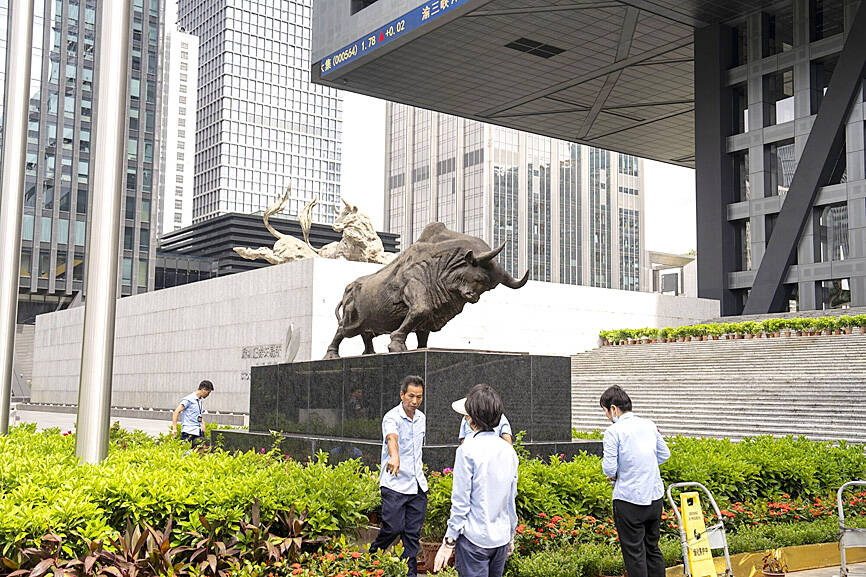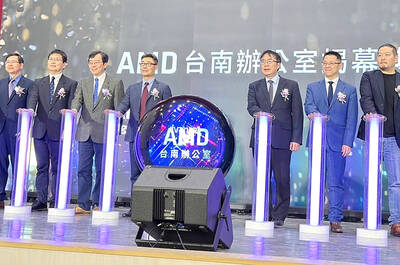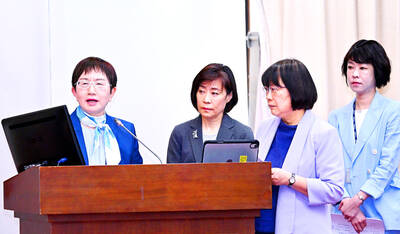China might see its first yearly outflow from equities this year — but if and when it happens, investors would not know from exchange data.
That is because the country’s stock exchanges would stop releasing daily data on overseas fund flows starting today, depriving investors of a key sentiment indicator to track the US$8.3 trillion market.
The change, first hinted at in April, comes as foreign funds have steadily withdrawn from the market, taking the year-to-date tally to negative as of Friday.

Photo: Raul Ariano, Bloomberg
Analysts saw the move as another effort by authorities to prop up the market, hoping to reduce volatility induced by high-frequency data and turn investor focus to longer-term indicators.
“Beijing stopped the release, because the data hasn’t been looking good, and it’s volatile,” abrdn Asia Ltd investment director Ng Xin-yao (黃新耀) said.
“They probably don’t want the data to amplify capital outflows,” but “it doesn’t solve the root of the problem,” he added.
If the selling persists, China might see the first annual outflow from its stock market since 2016, when Bloomberg began tracking purchases through the trading links with Hong Kong.
With the absence of data, investors would have to rely on the Chinese central bank’s quarterly reports on financial assets held by overseas entities for an indication.
Those are subject to a lag and measure the value of outstanding equities held by foreigners through broader channels, rather than flows.
China’s benchmark CSI 300 Index has fallen more than 9 percent since a May peak, as a hoped-for earnings recovery failed to materialize and policy support fell short.
Stocks have flopped even with massive purchases by state funds, with estimates that they plowed the equivalent of US$66 billion into exchange-traded funds this year.
There is little sign that an economic recovery is afoot. The latest data showed a surprise slowdown in fixed-asset investment and a softening in industrial production.
Global funds might find more reasons to shun China in the run-up to the US presidential elections, as anti-Beijing rhetoric and unfavorable trade measures are expected to gather pace.
“Market sentiment stagnates as more disappointing macro prints are released and policy easing remains reactive,” Morgan Stanley analysts including Laura Wang (王瀅) wrote in a note on Thursday. “We expect market volatility to remain relatively high and advise positioning more defensively in the near term.”
The latest decision followed an end to disclosing data on intraday flows through the trading links in May.
Last year, China asked fund houses to stop displaying real-time estimates of mutual fund products’ net value.
The lack of data transparency has been a constant issue in China, where the publication of some statistics has ceased without explanation — particularly in cases where the information has not been favorable for the economy or markets.
After the new rule takes effect, the only daily data published by the exchanges would be the total turnover and the number of trades made in stocks and exchange-traded funds via the Hong Kong links, as well as the turnover of the 10 most active securities. The total number of shares held through the links would be disclosed on a quarterly basis.
Real-time trading data for flows from China to Hong Kong, referred to as the southbound data, would still be available after this month’s deadline.

SECTOR LEADER: TSMC can increase capacity by as much as 20 percent or more in the advanced node part of the foundry market by 2030, an analyst said Taiwan Semiconductor Manufacturing Co (TSMC, 台積電) is expected to lead its peers in the advanced 2-nanometer process technology, despite competition from Samsung Electronics Co and Intel Corp, TrendForce Corp analyst Joanne Chiao (喬安) said. TSMC’s sophisticated products and its large production scale are expected to allow the company to continue dominating the global 2-nanometer process market this year, Chiao said. The world’s largest contract chipmaker is scheduled to begin mass production of chips made on the 2-nanometer process in its Hsinchu fab in the second half of this year. It would also hold a ceremony on Monday next week to

TECH CLUSTER: The US company’s new office is in the Shalun Smart Green Energy Science City, a new AI industry base and cybersecurity hub in southern Taiwan US chip designer Advanced Micro Devices Inc (AMD) yesterday launched an office in Tainan’s Gueiren District (歸仁), marking a significant milestone in the development of southern Taiwan’s artificial intelligence (AI) industry, the Tainan City Government said in a statement. AMD Taiwan general manager Vincent Chern (陳民皓) presided over the opening ceremony for the company’s new office at the Shalun Smart Green Energy Science City (沙崙智慧綠能科學城), a new AI industry base and cybersecurity hub in southern Taiwan. Facilities in the new office include an information processing center, and a research and development (R&D) center, the Tainan Economic Development Bureau said. The Ministry

ADVERSARIES: The new list includes 11 entities in China and one in Taiwan, which is a local branch of Chinese cloud computing firm Inspur Group The US added dozens of entities to a trade blacklist on Tuesday, the US Department of Commerce said, in part to disrupt Beijing’s artificial intelligence (AI) and advanced computing capabilities. The action affects 80 entities from countries including China, the United Arab Emirates and Iran, with the commerce department citing their “activities contrary to US national security and foreign policy.” Those added to the “entity list” are restricted from obtaining US items and technologies without government authorization. “We will not allow adversaries to exploit American technology to bolster their own militaries and threaten American lives,” US Secretary of Commerce Howard Lutnick said. The entities

Minister of Finance Chuang Tsui-yun (莊翠雲) yesterday told lawmakers that she “would not speculate,” but a “response plan” has been prepared in case Taiwan is targeted by US President Donald Trump’s reciprocal tariffs, which are to be announced on Wednesday next week. The Trump administration, including US Secretary of the Treasury Scott Bessent, has said that much of the proposed reciprocal tariffs would focus on the 15 countries that have the highest trade surpluses with the US. Bessent has referred to those countries as the “dirty 15,” but has not named them. Last year, Taiwan’s US$73.9 billion trade surplus with the US